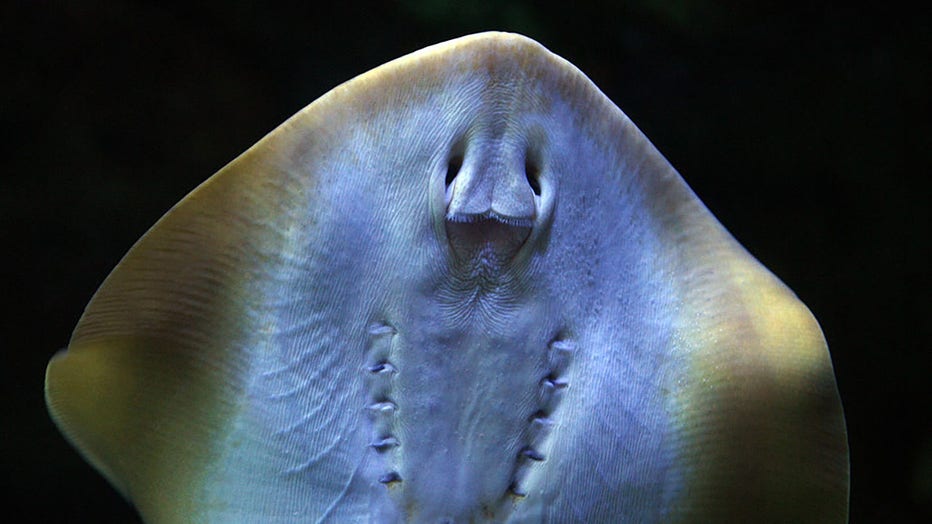Charlotte the stingray: Aquarium gives update on fish with virgin pregnancy

Giant freshwater stingray released back into Mekong River in Cambodia
Scientists say the giant stingray, measuring almost 13 feet from snout to tail, was caught in the Mekong River in Cambodia.
HENDERSONVILLE, N.C. - Charlotte, a stingray pregnant with pups despite having no male companion of her species, "continues to be healthy," according to aquarium staff.
Charlotte lives at the Aquarium and Shark Lab by Team ECCO in Hendersonville, North Carolina. Her pregnancy journey has captivated people all over the world and left many scratching their heads.
The serving platter-sized stingray has spent much of her life gliding around the confines of the storefront aquarium – some 2,300 miles from her natural habitat under the waves off southern California.
And most notably, she hasn’t shared a tank of water with a male of her species in at least eight years. The pregnancy was ultimately labeled as the result of parthenogenesis: a type of asexual reproduction in which offspring develop from unfertilized eggs – meaning there is no genetic contribution by a male.
In February, aquarium staff said Charlotte could give birth at any point, leaving fans captivated and eagerly awaiting any news. But with no precedent to look back on, there’s no real timeline to follow.
In March, staff said they were continuing to closely monitor the stingray, but there had been no changes to her eating, resting or swimming.
This week, aquarium staff wrote that Charlotte "is continuing on her journey with parthenogenesis."
"She continues to be healthy and has a great appetite! She also initiates interactions with the divers and guests as seen in this video with diver Jacob," the aquarium wrote alongside a video of Charlotte. "We thank you for your kindness and support as we continue on this journey of scientific learning."
Charlotte the stingray’s pregnancy journey
Charlotte’s pregnancy journey began in September 2023, when staff noticed how she was beginning to "swell."
"We documented multiple growths internally and initially thought she had a cancer," staff wrote at the time on Facebook.
The aquarium veterinarian later identified the growths as eggs, not cancer, much to the bewilderment of the staff. Her pregnancy was ultimately identified as parthenogenesis.
How does a stingray get pregnant without a mate?

FILE - A Bluespotted stingray swims in the Aquarium of the Pacific complex in Long Beach, California, on Nov. 8, 2006. (Photo credit: GABRIEL BOUYS/AFP via Getty Images)
The vet noted there have been a few cases of asexual reproduction without fertilization in stingrays, but this is the first known case of parthenogenesis in a captive California round stingray.
The rare phenomenon can occur in some insects, fish, amphibians, birds and reptiles, but not mammals. Documented examples have included California condors, Komodo dragons and yellow-bellied water snakes.
An expert on the stingrays said it would have been impossible for Charlotte to have mated with one of the five small sharks that share her tank, despite news reports suggesting that was the case after the aquarium’s executive director, Brenda Ramer, joked about a possible interspecies hookup.
The small aquarium is run by Ramer’s educational nonprofit, Team ECCO, which encourages local schoolchildren and others to take an interest in science.
Kady Lyons, a research scientist at the Georgia Aquarium in Atlanta who is not involved with the North Carolina aquarium, said Charlotte’s pregnancy is the only documented example she’s aware of for this species, round stingrays.
But Lyons isn’t at all shocked. Other kinds of sharks, skates and rays — a trio of animals often grouped together — have had these kinds of pregnancies in human care.
"I’m not surprised, because nature finds a way of having this happen," she said.
To be clear, Lyons said, these animals are not cloning themselves. Instead, a female’s egg fuses with another cell, triggers cell division and leads to the creation of an embryo.
The cell that fuses with the egg is known as a polar body. They are produced when a female is creating an egg but usually aren’t used.
"We don’t know why it happens," Lyons said. "Just that it’s kind of this really neat phenomenon that they seem to be able to do."
Ramer said she and others at the nonprofit at first thought that Charlotte had a tumor when they noticed a lump on her back that was "blowing up like a biscuit." But an ultrasound revealed her pregnancy.
"We were all like, ’Shut the back door. There’s no way," Ramer said. "We thought we were overfeeding her. But we were overfeeding her because she has more mouths to feed."
Charlotte currently lives in a tank that’s about 2,200 gallons (8,300 liters), or nearly the size of a construction dumpster. Ramer said they’re hoping to get a tank nearly twice that size to accommodate Charlotte’s offspring. They also want to put live cameras up for people to see them.
"It is very rare to happen," Ramer said. "But it’s happening in the middle of the Blue Ridge Mountains in rural North Carolina, hundreds of miles from the ocean."
As for the suggestion that Charlotte could have been impregnated by a shark, Lyons said that’s impossible. Besides being different sizes, the animals wouldn’t match up anatomically. Neither would their DNA.
"We should set the record straight that there aren’t some shark-ray shenanigans happening here," said Lyons, whose graduate work focused on the species.
This story was reported from Cincinnati. The Associated Press contributed.

